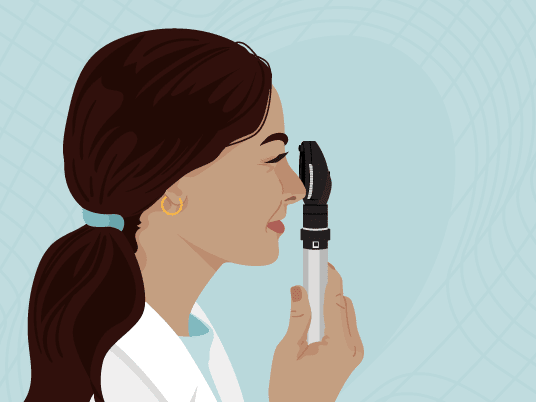- Dry AMD vs. GA
- Progression
- Prevalence
- Who is at risk?
- Symptoms
- Treatment
- Summary
Geographic atrophy is a subtype of advanced age-related macular degeneration (AMD). It causes blind spots in the center of vision and a permanent loss of visual sharpness.
AMD progresses through several stages, usually starting with dry AMD, which is the more common form of the condition. It advances to geographic atrophy (GA) in some cases.
Both conditions damage the macula, the area of the retina responsible for sharp central vision. However, GA involves more significant and irreversible loss of retinal tissue. Therefore, the difference between geographic atrophy and dry AMD lies in the severity and stage of the condition.
This article explores the differences between geographic atrophy and dry AMD, how these conditions affect the eye, and who is at risk.
Dry AMD vs. geographic atrophy
 Share on PinterestStefania Pelfini, La Waziya Photography/Getty Images
Share on PinterestStefania Pelfini, La Waziya Photography/Getty Images
Dry AMD, also known as nonexudative AMD, is the most common formTrusted Source of AMD. It causes the buildup of tiny yellow deposits beneath the retina, known as drusen, which gradually damage the macula.
In the early stages, dry AMD may cause minimal symptoms, but as it advances, it can lead to blurry vision and difficulty seeing fine details.
In some cases, dry AMD progresses to geographic atrophy (GA), a type of dry AMD that involves the death of retinal cells, photoreceptors, and the choroid of the macula. The latter supplies the tissue with blood and nutrients.
The loss of these cells leads to significant central vision loss, although peripheral vision may remain intact. Over time, GA progresses, enlarging areas of atrophy and increasing the loss of vision.
While both dry AMD and GA affect the macula and central vision, GA represents a more severeTrusted Source stage of the disease.
How dry AMD progresses
Health professionals divide macular degeneration into four stagesTrusted Source according to the macula’s appearance during an eye exam. These stages include:
- Group 1 (no AMD): There are no drusen or only a few small ones.
- Group 2 (early stage AMD): There are more small or some medium-sized drusen, but no significant damage or GA.
- Group 3 (intermediate stage): There is one large druse or many medium-sized drusen and some non-central GA outside the central part of vision.
- Group 4 (advanced stage): This refers to significant central GA to the central part of the retina, or atypical blood vessel growth and wet AMD.
Dry AMD tends to progress slowly, sometimes over several years. However, once it reaches the stage of GA, vision impairment becomes much more noticeable.

HEALTHLINE NEWSLETTER
Get our Macular Degeneration Newsletter
Improve your eye health with our macular degeneration newsletter. Receive expert advice on managing your condition, answers to your FAQs, and the latest on condition breakthroughs delivered to your inbox.
Enter your emailJOIN NOWAlso sign up for our popular Heart Health newsletter
Your privacy is important to us
How many people with AMD get GA?
Not all individuals with dry AMD develop GA. However, a 2023 study found that 60%Trusted Source of those with eyes with AMD also have GA.
Who is at risk of GA?
According to a 2020 review of past research, several factors are known to increase the risk of AMD progression, such as:
- older age
- smoking
- a high glycemic index diet
- genetics
Researchers are still investigating the potential relationship between AMD progression and other factors, such as diabetes, hypertension, and obesity.
Symptoms of dry AMD vs. GA
The symptoms of dry AMD can includeTrusted Source:
- blurry vision
- difficulty seeing in low light or at night
- needing brighter lighting to see clearly during activities such as reading or cooking
- distorted vision, such as straight lines appearing wavy or bent
- slow recovery of visual function after bright light exposure
As dry AMD progresses, individuals may begin to notice blind spots in the center of their vision. When a person has GA, they have significant loss of central vision.
As a result, they may have difficulty recognizing faces and an impaired ability to perform daily activities.
Treatment for dry AMD and GA
Currently, there is no cure for dry AMD or GA, but several treatmentsTrusted Source may help slow the progression of the disease and manage its symptoms. These include:
- Medications: Some new medications can slow the rate of GA. These include Syfovre (pegcetacoplan) and Izervay (avacincaptad pegol), both of which involve regular injections into the eye. In clinical trials, these treatments slowed the development of GA by 14% to 20% but can cause side effects, such as:
- bleeding
- inflammation
- blurry vision
- temporary increase in eye pressure
- Nutritional supplements: The AREDS (Age-Related Eye Disease Study) supplement formulation, which includes vitamins C and E, zinc, copper, lutein, and zeaxanthin, can slow the progression of dry AMD.
- Vision aids: Magnifying lenses, special glasses, and electronic devices can help people maintain independence and perform everyday tasks.
- Lifestyle changes: Quitting or avoiding smoking, exercising regularly, and eating a nutrient-rich diet high in leafy greens, fish, and antioxidants may helpTrusted Source slow AMD progression.
Summary
Geographic atrophy (GA) is an advanced form of dry age-related macular degeneration (AMD). As AMD progresses, it can lead to damage to the macula, significantly affecting central vision. While not all people with dry AMD develop GA, those who do experience more significant visual impairments.
Early diagnosis, lifestyle modifications, and the use of nutritional supplements may help slow the progression. While there is no cure for dry AMD, ongoing research into new therapies offers potential hope for better management and treatment options in the future.

Leave a Reply